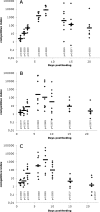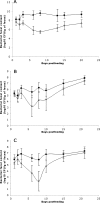A genomic island of an extraintestinal pathogenic Escherichia coli Strain enables the metabolism of fructooligosaccharides, which improves intestinal colonization
- PMID: 18978057
- PMCID: PMC2612441
- DOI: 10.1128/JB.01052-08
A genomic island of an extraintestinal pathogenic Escherichia coli Strain enables the metabolism of fructooligosaccharides, which improves intestinal colonization
Abstract
Prebiotics such as fructooligosaccharides (FOS) are increasingly being used in some countries for improving human and animal health and as an alternative to antibiotic growth promoters in animals, with various degrees of success. It has been observed that FOS stimulate the proliferation of probiotic bacteria and, at the same time, decrease the population of bacteria associated with disease. This observation assumes that pathogenic bacteria do not metabolize FOS and, therefore, lose their competitive advantage over beneficial bacteria. Here we present evidence that some pathogenic Escherichia coli strains can metabolize FOS and show that this property helps the bacterium colonize the intestine. These findings highlight the potential risk that a high level of prebiotic usage could lead to the emergence of well-adapted pathogenic strains that metabolize prebiotic substances.
Figures





Similar articles
-
Effect of fructooligosaccharide metabolism on chicken colonization by an extra-intestinal pathogenic Escherichia coli strain.PLoS One. 2012;7(4):e35475. doi: 10.1371/journal.pone.0035475. Epub 2012 Apr 13. PLoS One. 2012. PMID: 22514747 Free PMC article.
-
Intestine and environment of the chicken as reservoirs for extraintestinal pathogenic Escherichia coli strains with zoonotic potential.Appl Environ Microbiol. 2009 Jan;75(1):184-92. doi: 10.1128/AEM.01324-08. Epub 2008 Nov 7. Appl Environ Microbiol. 2009. PMID: 18997030 Free PMC article.
-
Transcriptional regulation through RfaH contributes to intestinal colonization by Escherichia coli.FEMS Microbiol Lett. 2005 Mar 1;244(1):173-80. doi: 10.1016/j.femsle.2005.01.038. FEMS Microbiol Lett. 2005. PMID: 15727837
-
(Patho-)Genomics of Escherichia coli.Int J Med Microbiol. 2005 Oct;295(6-7):357-71. doi: 10.1016/j.ijmm.2005.07.009. Int J Med Microbiol. 2005. PMID: 16238013 Review.
-
Pathogenic diversity of Escherichia coli and the emergence of 'exotic' islands in the gene stream.Vet Res. 1999 Mar-Jun;30(2-3):157-79. Vet Res. 1999. PMID: 10367353 Review.
Cited by
-
Dietary Sugars Analysis: Quantification of Fructooligossacharides during Fermentation by HPLC-RI Method.Front Nutr. 2014 Jul 31;1:11. doi: 10.3389/fnut.2014.00011. eCollection 2014. Front Nutr. 2014. PMID: 25988114 Free PMC article.
-
Fecal Carriage of Extended-Spectrum-β-Lactamase/AmpC-Producing Escherichia coli in Horses.Appl Environ Microbiol. 2020 Apr 1;86(8):e02590-19. doi: 10.1128/AEM.02590-19. Print 2020 Apr 1. Appl Environ Microbiol. 2020. PMID: 32033947 Free PMC article.
-
Role of the vpe carbohydrate permease in Escherichia coli urovirulence and fitness in vivo.Infect Immun. 2012 Aug;80(8):2655-66. doi: 10.1128/IAI.00457-12. Epub 2012 May 21. Infect Immun. 2012. PMID: 22615242 Free PMC article.
-
Metabolism and Fitness of Urinary Tract Pathogens.Microbiol Spectr. 2015 Jun;3(3):10.1128/microbiolspec.MBP-0016-2015. doi: 10.1128/microbiolspec.MBP-0016-2015. Microbiol Spectr. 2015. PMID: 26185076 Free PMC article.
-
Effect of diet on pathogen performance in the microbiome.Microbiome Res Rep. 2022 Mar 26;1(2):13. doi: 10.20517/mrr.2021.10. eCollection 2022. Microbiome Res Rep. 2022. PMID: 38045644 Free PMC article. Review.
References
-
- Apanavicius, C. J., K. L. Powell, B. M. Vester, L. K. Karr-Lilienthal, L. L. Pope, N. D. Fastinger, M. A. Wallig, K. A. Tappenden, and K. S. Swanson. 2007. Fructan supplementation and infection affect food intake, fever, and epithelial sloughing from Salmonella challenge in weanling puppies. J. Nutr. 1371923-1930. - PubMed
-
- Barnes, H. J., J.-P. Vaillancourt, and W. B. Gross. 2003. Colibacillosis, p. 631-652. In Y. M. Saif, H. J. Barnes, J. R. Glisson, A. M. Fadly, L. R. McDougald, and D. E. Swayne (ed.), Diseases of poultry, 11th ed. Iowa State University Press, Ames.
-
- Berg, E. L., C. J. Fu, J. H. Porter, and M. S. Kerley. 2005. Fructooligosaccharide supplementation in the yearling horse: effects on fecal pH, microbial content, and volatile fatty acid concentrations. J. Anim. Sci. 831549-1553. - PubMed
-
- Blattner, F. R., G. Plunkett III, C. A. Bloch, N. T. Perna, V. Burland, M. Riley, J. Collado-Vides, J. D. Glasner, C. K. Rode, G. F. Mayhew, J. Gregor, N. W. Davis, H. A. Kirkpatrick, M. A. Goeden, D. J. Rose, B. Mau, and Y. Shao. 1997. The complete genome sequence of Escherichia coli K-12. Science 2771453-1474. - PubMed
Publication types
MeSH terms
Substances
LinkOut - more resources
Full Text Sources
Molecular Biology Databases

